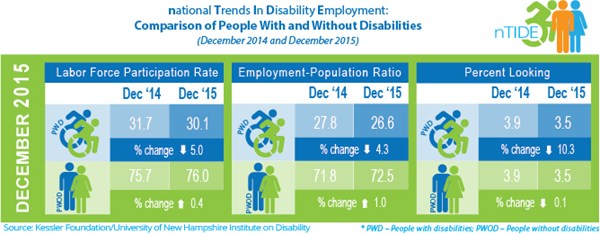WEST ORANGE, N.J., Jan. 8, 2016 (GLOBE NEWSWIRE) -- For the fourth straight month, Americans with disabilities continue to struggle with finding employment, while the job market for people without disabilities slightly improved, according to today's National Trends in Disability Employment – Monthly Update (nTIDE), issued by Kessler Foundation and University of New Hampshire's Institute on Disability (UNH-IOD). In an effort to create or expand employment opportunities for people with disabilities, Kessler Foundation distributed grants to disability employment initiatives across the U.S.
In the Bureau of Labor Statistics' Jobs Report released Friday, January 8, the employment-to-population ratio for working-age people with disabilities decreased from 27.8 percent in December 2014 to 26.6 percent in December 2015 (down 4.3 percent; 1.2 percentage points). For working-age people without disabilities, the employment-to-population ratio increased slightly from 71.8 percent in December 2014 to 72.5 percent in December 2015 (up 1.0 percent; 0.7 percentage points). The employment-to-population ratio, a key indicator, reflects the percentage of people who are working relative to the total population (the number of people working divided by the number of people in the total population multiplied by 100).
"The employment to population ratio for people with disabilities has deteriorated over the past four months," according to John O'Neill, Ph.D., director of employment and disability research at Kessler Foundation. "Over the same time period the employment to population ratio for people without disabilities has either shown small improvements or deteriorated but to a lesser degree than for people with disabilities."
The labor force participation rate of people with disabilities also decreased from 31.7 percent in December 2014 to 30.1 percent in December 2015 (down 5.0 percent; 1.6 percentage points). For people without disabilities, the labor force participation rate increased slightly from 75.7 percent in December 2014 to 76.0 percent in December 2015 (down 0.4 percent; 0.3 percentage points). The labor force participation rate is the percentage of the population that is working or actively looking for work.
"It will be interesting to see if 2015, overall, was a positive year for people with disabilities, which we will do in year-in-review report. Although, I'd rather go into next year with the monthly trend heading in a positive direction, we didn't see that at the end of 2015," said Andrew Houtenville, Ph.D., associate professor of economics at UNH.
Kessler Foundation recently announced $1.6 million in funding for major employment initiatives in four states. In Florida, funding was awarded to Bridging the Gap from College to Careers, an initiative of the Florida Atlantic University Foundation. In Illinois, Access Living of Metropolitan Chicago will launch the Realizing Education and Advancement for Disabled Youth (READY) program to help students transition to college, employment and economic independence. The Maryland Customized Employment Project will improve employment outcomes for individuals with developmental disabilities through collaborative partnerships with state agencies and employers. The Mercy Health Foundation's Healthcare Workforce Inclusion Model will place individuals with disabilities in new and existing opportunities in St. Louis, Missouri.
"Employment opportunities are fundamental to improving quality of life for people with disabilities. To counter the negative labor trends, funding organizations need to prioritize support for innovative, sustainable employment initiatives," said Elaine E. Katz, MS, senior vice president of Grants & Communications. "Through our signature employment grants, we seek to fund large-scale programs that focus on preparing individuals for lasting and fulfilling jobs that promote financial independence."
Since 2000, Kessler Foundation has provided $33.6 million to expand job opportunities for people with disabilities. The Foundation awards community employment grants and funds related special initiatives, in addition to its two-year signature employment grants, which range from $200,000 to $500,000.
In December 2015, among workers ages 16-64, the 4,141,000 workers with disabilities represented 2.9 percent of the total 141,151,000 workers in the U.S.
"The statistics in nTIDE are not seasonally adjusted," noted Dr. O'Neill. "Because disability employment data have been collected for so few years, more time is needed for seasonal trends to become evident."
The next nTIDE will be issued on Friday, February 5, 2016.
NOTE: The statistics in the National Trends in Disability Employment – Update are based on Bureau of Labor Statistics numbers, but are NOT identical. They have been customized by the University of New Hampshire to efficiently combine the statistics for men and women of working age (16 to 64).
nTIDE is funded, in part, by grants from the National Institute on Disability, Independent Living and Rehabilitation Research (NIDILRR) (H133B130015 & H133B120005) and Kessler Foundation.
About Kessler Foundation
Kessler Foundation, a major nonprofit organization in the field of disability, is a global leader in rehabilitation research that seeks to improve cognition, mobility and long-term outcomes, including employment, for people with neurological disabilities caused by diseases and injuries of the brain and spinal cord. Kessler Foundation leads the nation in funding innovative programs that expand opportunities for employment for people with disabilities. For more information, visit KesslerFoundation.org.
About the Institute on Disability at the University of New Hampshire
The Institute on Disability (IOD) at the University of New Hampshire (UNH) was established in 1987 to provide a coherent university-based focus for the improvement of knowledge, policies, and practices related to the lives of persons with disabilities and their families. For information on the NIDILRR-funded Employment Policy and Measurement Rehabilitation Research and Training Center, visit http://www.ResearchonDisability.org.
For more information, or to interview an expert, contact:
Lauren Scrivo, 973.768.6583, LScrivo@KesslerFoundation.org
Carolann Murphy, 973.324.8382, CMurphy@KesslerFoundation.org
A photo accompanying this release is available at: http://www.globenewswire.com/newsroom/prs/?pkgid=38383
